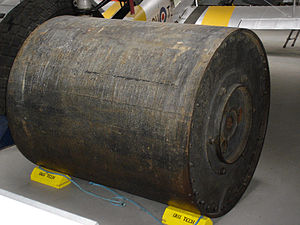Bouncing bomb
| Vickers Type 464 code name: Upkeep |
|
|---|---|

Upkeep bouncing bomb at the Imperial War Museum Duxford
|
|
| Type | Conventional (depth charge) |
| Place of origin |
|
| Service history | |
| In service | 16–17 May 1943 (Operation Chastise) |
| Used by | No. 617 Squadron RAF |
| Wars | World War II |
| Production history | |
| Designer | Barnes Wallis |
| Designed | April 1942 |
| Manufacturer | Vickers-Armstrongs |
| Produced | February 1943 |
| No. built | 120 (62 inert and 58 HE filled) 19 used operationally |
| Variants | Highball spherical bouncing bomb, inert training bombs |
| Specifications | |
| Weight | 9,250 pounds (4,196 kg) |
| Length | 60 inches (152 cm) |
| Width | 50 inches (127 cm) |
|
|
|
| Muzzle velocity | 240–250 miles per hour (386–402 km/h) 500 rpm back-spin |
| Effective firing range | 400–500 yards (366–457 m) |
| Filling | Torpex |
| Filling weight | 6,600 pounds (2,994 kg) |
|
Detonation
mechanism |
hydrostatic fuze (depth of 30 feet (9.1 m)) with backup chemical time fuze. |
A bouncing bomb is a bomb designed to bounce to a target across water in a calculated manner to avoid obstacles such as torpedo nets, and to allow both the bomb's speed on arrival at the target and the timing of its detonation to be pre-determined, in a similar fashion to a regular naval depth charge. The inventor of the first such bomb was the British engineer Barnes Wallis, whose "Upkeep" bouncing bomb was used in the RAF's Operation Chastise of May 1943 to bounce into German dams and explode underwater, with effect similar to the underground detonation of the Grand Slam and Tallboy earthquake bombs, both of which he also invented.
Barnes Wallis' April 1942 paper "Spherical Bomb — Surface Torpedo" described a method of attack in which a weapon would be bounced across water until it struck its target, then sinking to explode underwater, much like a depth charge. Bouncing it across the surface would allow it to be aimed directly at its target, while avoiding underwater defences, as well as some above the surface, and such a weapon would take advantage of the "bubble pulse" effect typical of underwater explosions, greatly increasing its effectiveness: Wallis's paper identified suitable targets as hydro-electric dams "and floating vessels moored in calm waters such as the Norwegian fjords".
Both types of target were already of great interest to the British military when Wallis wrote his paper (which itself was not his first on the subject); German hydro-electric dams had been identified as important bombing targets before the outbreak of World War II, but existing bombs and bombing methods had little effect on them, as torpedo nets protected them from attack by conventional torpedoes and a practical means of destroying them had yet to be devised. In 1942, the British were seeking a means of destroying the German battleship Tirpitz, which posed a threat to Allied shipping in the North Atlantic and had already survived a number of British attempts to destroy it. During this time, the Tirpitz was being kept safe from attack by being moored in Norwegian fjords, where it had the effect of a "fleet in being". Consequently, Wallis's proposed weapon attracted attention and underwent active testing and development.
...
Wikipedia
